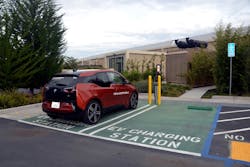EV charging presents challenges and opportunities for independent repair shops
In November, the U.S. Congress passed H.R. 3684, the Infrastructure Investment and Jobs Act, also known as the bipartisan infrastructure bill. The $1.2 trillion piece of legislation is a monumental investment in our nation’s infrastructure and includes $550 billion of new spending.
The bipartisan infrastructure bill includes a variety of traditional infrastructure projects, such as revitalizing the nation’s roads, bridges, and railways. However, the legislation has many non-traditional infrastructure priorities as well, such as high-speed internet, climate change projects, and environmental justice. Included is $7.5 billion for installing a nationwide network of electric vehicle charging stations.
According to the J.D. Power 2021 Electric Vehicle Experience (EVX) Ownership Study, the factor most cited in a decision on whether to buy an electric vehicle is range anxiety. Prospective electric vehicle owners are concerned that the car will not be able to travel long distances, due to difficulty finding a convenient place to charge. This issue is a barrier for both manufacturers trying to sell electric vehicles, and governments attempting to spur consumer adoption of cleaner modes of transportation.
The Infrastructure Investment in Jobs Act seeks to remedy the electric vehicle range anxiety issue by investing in a national network of EV charging stations. President Joe Biden has set a goal of 500,000 public charging stations by 2030. Achieving this will complement the President’s additional goal of 50 percent EV sales in the United States by 2030.
In late November, the U.S. Department of Transportation (DOT) took the first steps in establishing programs for the electric vehicle charging stations, as mandated in the Infrastructure Investment and Jobs Act. The agency posted a request for comments from stakeholders on best practices to develop guidance for two EV charging station programs: the National Electric Vehicle Formula Program and the Charging and Fueling Infrastructure program.
The National Electric Vehicle Formula program will distribute money only to states in an amount calculated by formula. The charging stations created through this program are required to be located on designated authorized fuel corridors and will be exclusively electric charging stations. Separately, the Charging and Fueling Infrastructure program will be a discretionary grant program available to cities and other entities, not just states. Additionally, charging stations will not be required to be located on designated authorized fuel corridors and grants will be available for hydrogen, natural gas, and propane fueling stations in addition to EV charging stations.
According to the DOT, discretionary grant funds from the Charging and Fueling Infrastructure program must be used “only for EV charging station infrastructure that is open to the general public or to authorized commercial vehicle owners from more than one company.” This is of interest because it specifically excludes Tesla, whose charging stations are proprietary and therefore are only able to charge Tesla brand vehicles. Earlier this year, Tesla CEO Elon Musk announced that Tesla Supercharger Network would be open to other types of vehicles in 2021. To date, only 10 charging stations in the Netherlands have been opened.
The $7.5 billion included in the Infrastructure Investment and Jobs Act for 500,000 new EV charging stations is a good start. However, the question remains: will this be enough to spur the widespread adoption of electric vehicles? According to a study by the California Energy Commission, the state of California alone will need 1.2 million public and shared charging stations to meet the demands of California electric vehicle consumers. Currently, the United States has about 43,000 public charging station locations, with approximately 120,000 charging ports.
Last year, electric vehicles made up only 1.7% of new light-duty vehicles sold in the U.S. As the automotive industry moves towards an increasingly electric future, it will be important for independent automotive repair shops to be prepared for this shift. The development of a national network of electric vehicle charging stations will present both a challenge and an opportunity for our industry.
About the Author
Madi Hawkins
Madi Hawkins works as a Washington D.C. representative of the Automotive Service Association (ASA). She is a recent graduate of Vanderbilt University, where she graduated with a B.A. of Public Policy Studies.

